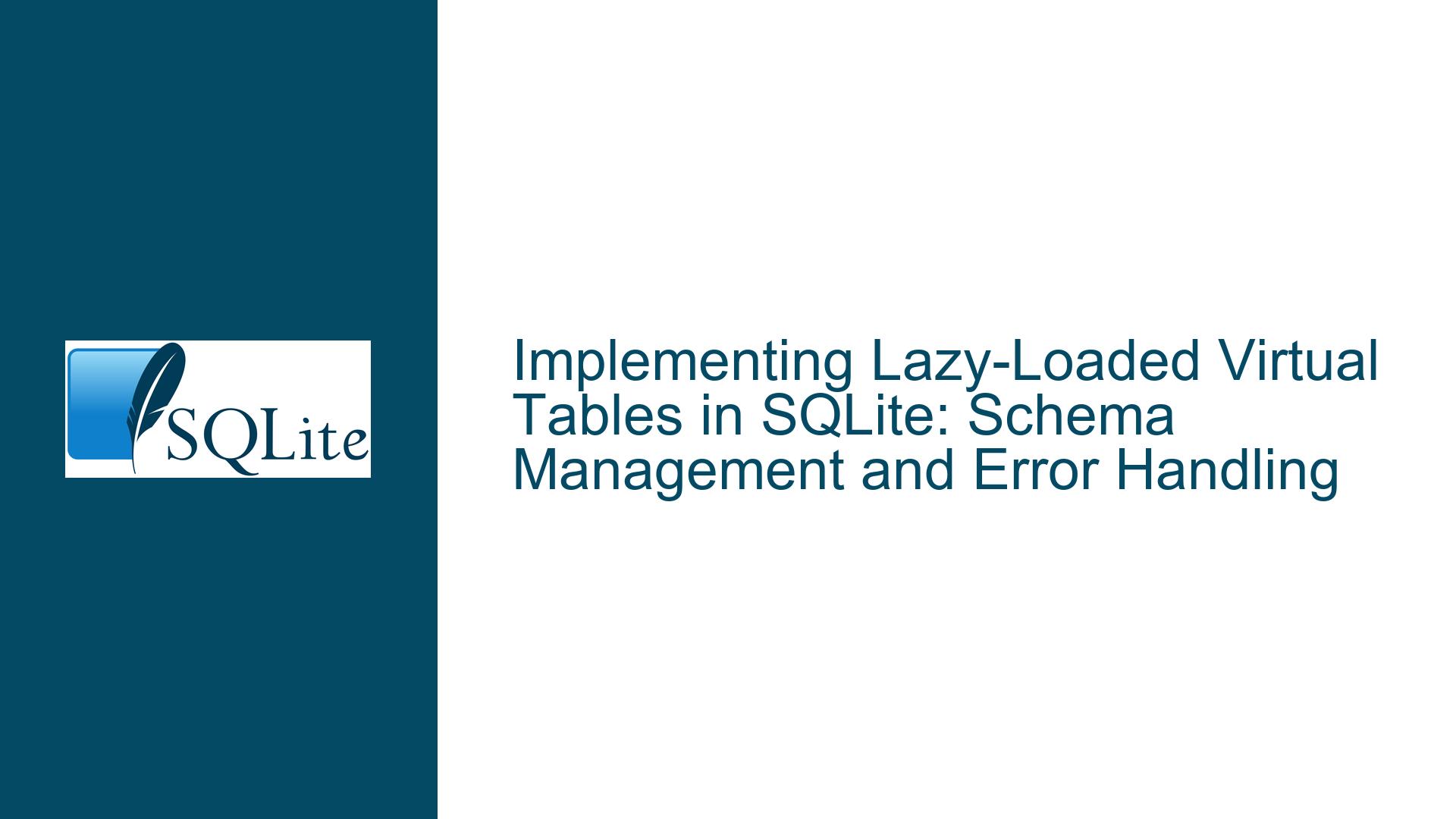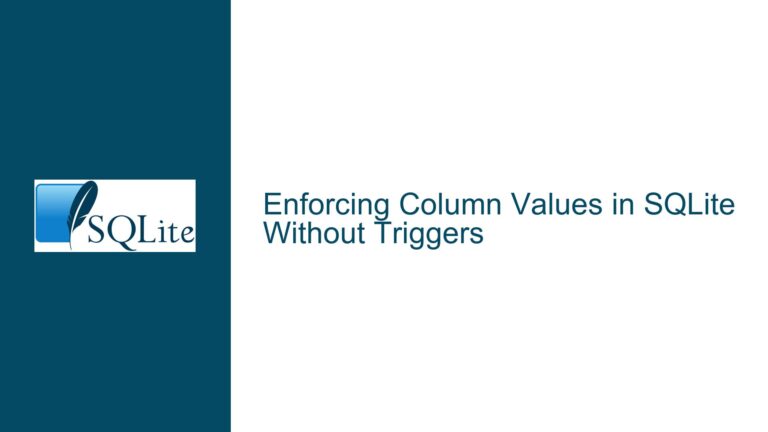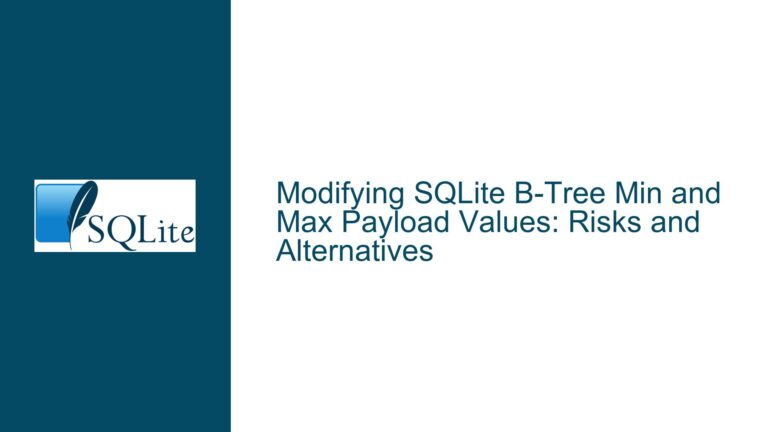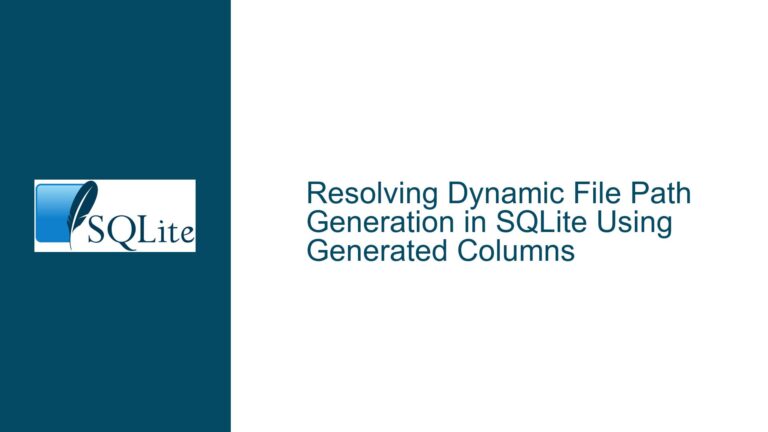Implementing Lazy-Loaded Virtual Tables in SQLite: Schema Management and Error Handling
Understanding Lazy-Loaded Virtual Tables with Eponymous-Only Modules and Temporary Table Initialization
Issue Overview
The core challenge revolves around designing a virtual table in SQLite that defers data population until the first access attempt, a concept colloquially termed "lazy loading." The implementation described uses an eponymous-only virtual table module combined with a temporary table created during the xOpen callback. When the virtual table is accessed, the xOpen method generates a temporary table with the same name as the virtual table, populates it with data, and returns SQLITE_SCHEMA to force SQLite’s query planner to reload the schema. If the xOpen method detects multiple invocations (e.g., due to schema reloading), it returns SQLITE_CORRUPT_VTAB to signal an abnormal state.
This approach introduces several critical dependencies:
- Schema Reload Semantics: Returning
SQLITE_SCHEMAfromxOpenforces SQLite to invalidate all prepared statements and reload the schema. This is a heavy-handed operation that can degrade performance and lead to unintended side effects in concurrent environments. - Temporary Table Scope: Temporary tables in SQLite are session-specific. By creating a temporary table with the same name as the virtual table, the implementation effectively shadows the virtual table within the session. This creates ambiguity when multiple sessions or connections interact with the same database.
- Error Code Ambiguity: Using
SQLITE_CORRUPT_VTABto handle repeatedxOpencalls is semantically incorrect. TheSQLITE_CORRUPT_VTABerror is reserved for structural inconsistencies in the virtual table implementation, not for managing control flow.
The primary risks include infinite schema-reload loops, inconsistent data visibility across sessions, and misdiagnosis of runtime errors due to improper use of SQLite’s error codes.
Root Causes of Instability in Lazy-Loaded Virtual Table Implementations
Overloading
xOpenfor Schema Changes:
ThexOpenmethod in a virtual table module is designed to instantiate cursor objects for iterating through rows. Using it to modify the schema (by creating temporary tables) violates the principle of separation between data access and schema management. SQLite assumes that schema changes do not occur during cursor initialization, and violating this assumption can destabilize the query planner.Incorrect Error Code Propagation:
ReturningSQLITE_SCHEMAfromxOpentriggers a schema reload, but this error is typically generated by the SQLite core—not virtual table implementations—when a prepared statement detects a schema change. Forcing this error manually can bypass SQLite’s internal consistency checks, leading to unprepared statements referencing invalid schemas.Race Conditions During Schema Reload:
When multiple threads or connections access the virtual table simultaneously, the temporary table creation step may not be atomic. This can result in incomplete data visibility or conflicts between sessions attempting to create the same temporary table.Lack of State Management:
The virtual table module does not track whether the temporary table has already been populated. Relying onSQLITE_SCHEMAto indirectly manage this state is brittle, as subsequent queries may skip initialization steps if the schema is not invalidated correctly.Ephemeral Nature of Temporary Tables:
Temporary tables are bound to the database connection and are automatically dropped when the connection closes. If the virtual table is accessed across multiple connections, each connection will create its own temporary table, leading to data duplication and increased memory consumption.
Resolving Lazy-Loaded Virtual Table Initialization and Schema Management
Step 1: Re-architect the Virtual Table Module
Instead of using xOpen to create temporary tables, leverage the xCreate or xConnect methods to initialize persistent data structures. These methods are invoked when the virtual table is first created (xCreate) or when a database connection attaches to an existing virtual table (xConnect).
Persistent Shadow Tables:
Create an internal (non-temporary) table that stores the lazily loaded data. UseCREATE TABLE IF NOT EXISTSinxCreate/xConnectto ensure the shadow table exists. The virtual table’sxBestIndexandxFiltermethods can then populate this table on first access.Deferred Population with Triggers:
Attach aBEFORE INSERTtrigger to the shadow table that populates it with initial data when the first write operation occurs. This defers initialization until the first actual interaction with the table.
Step 2: Eliminate Manual Schema Reloads
Avoid returning SQLITE_SCHEMA from virtual table methods. Instead, design the module to handle lazy initialization transparently:
Check-and-Populate in
xFilter:
In thexFiltermethod (called when a query starts executing), check if the shadow table is empty. If so, populate it with initial data. This ensures initialization occurs on first access without disrupting the schema.Use
sqlite3_declare_vtab()for Dynamic Schemas:
If the virtual table’s schema depends on runtime data, usesqlite3_declare_vtab()duringxCreate/xConnectto define the schema programmatically. This avoids hardcoding column definitions and allows dynamic adjustment.
Step 3: Implement Proper Error Handling
Replace SQLITE_CORRUPT_VTAB with context-specific error codes or state flags to manage reentrant xOpen calls:
Reentrancy Flags:
Add a static or thread-local flag to track whetherxOpenis already executing. If a reentrant call is detected, returnSQLITE_BUSYinstead ofSQLITE_CORRUPT_VTAB.Asynchronous Initialization:
Use a mutex or atomic operation to protect the temporary table creation step, ensuring only one thread or connection initializes the data.
Step 4: Optimize Temporary Table Usage
If temporary tables are unavoidable, refine their scope and lifecycle:
Session-Specific Initialization:
Attach the temporary table to the database connection usingsqlite3_db_config(db, SQLITE_DBCONFIG_ENABLE_TRIGGER, 1, 0), ensuring it persists for the duration of the session.Explicit Cleanup:
Register asqlite3_update_hookcallback to detect when the virtual table is dropped or altered, and explicitly delete the temporary table to prevent orphaned objects.
Step 5: Validate with SQLite’s EXPLAIN QUERY PLAN
Use EXPLAIN QUERY PLAN to verify that queries against the virtual table utilize indexes and scans efficiently after lazy initialization. Ensure that the query planner does not generate redundant subqueries or full-table scans due to schema changes.
Final Solution Code Sketch
// In xConnect:
static int vt_connect(sqlite3 *db, void *pAux, int argc, const char *const*argv, sqlite3_vtab **ppVt, char **pErr) {
sqlite3_declare_vtab(db, "CREATE TABLE ...");
sqlite3_exec(db, "CREATE TABLE IF NOT EXISTS shadow_table (...);", 0, 0, 0);
// Initialize virtual table structure
}
// In xOpen:
static int vt_open(sqlite3_vtab *pVTab, sqlite3_vtab_cursor **ppCursor) {
// Create cursor without modifying schema
}
// In xFilter:
static int vt_filter(sqlite3_vtab_cursor *pCursor, int idxNum, const char *idxStr, int argc, sqlite3_value **argv) {
VTCursor *pCur = (VTCursor *)pCursor;
sqlite3 *db = pCur->pVtab->db;
// Check if shadow_table is empty
if (is_shadow_table_empty(db)) {
populate_shadow_table(db);
}
// Proceed with query execution
}
This approach eliminates schema reloads, ensures thread-safe initialization, and maintains compatibility with multiple database connections. By leveraging SQLite’s native virtual table lifecycle methods, it adheres to best practices for performance and stability.






